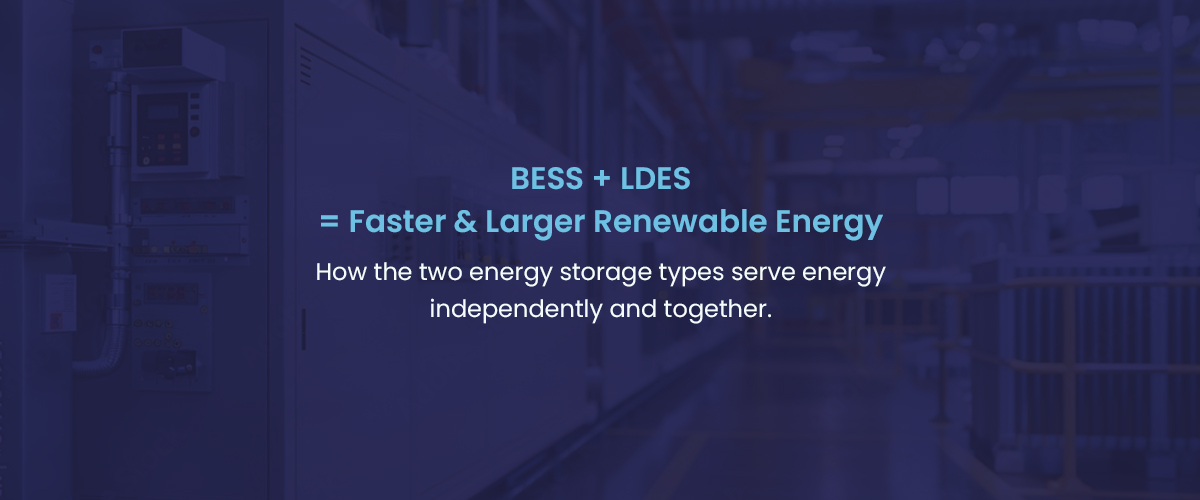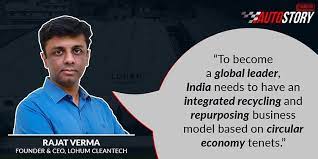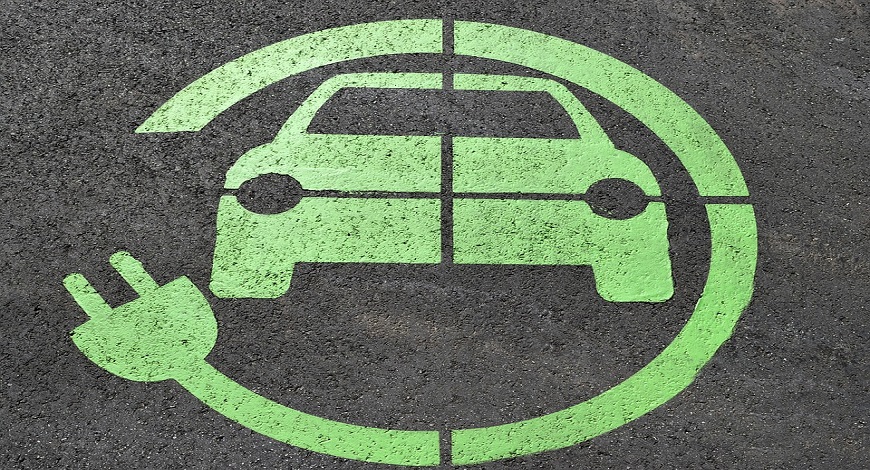
Table of Contents
The integration of renewable energy sources into power grids is accelerating the need for advanced and diversified energy storage solutions. While short-duration battery energy storage systems (BESS) are increasingly commonplace, the intermittent nature of renewables necessitates longer-term storage capabilities.
Long Duration Energy Storage (LDES) thus emerges as a critical component in the energy transition, offering the potential to bridge the gap between renewable energy generation and electricity demand. This edition of the LOHUM Green Gazette delves into the synergistic relationship between LDES and Li-ion batteries, exploring their complementary roles in grid stabilization, renewable energy integration, peak shaving, and energy market participation.
By understanding the intricacies of these technologies and their interactions, we can accelerate the shift to a sustainable, abundant, and resilient energy future.
What is Long Duration Energy Storage (LDES)?
Long Duration Energy Storage (LDES) refers to energy storage systems capable of discharging energy for extended periods, typically defined as 10 hours or more. Unlike shorter-duration storage technologies, LDES is designed to bridge the gap between intermittent renewable energy generation, such as solar and wind, and the consistent demand for electricity.
It is crucial for enabling a grid with a high penetration of renewables, as it can store surplus energy during periods of overgeneration and discharge it during periods of high demand or low renewable output, and do so for longer durations than most current-gen battery technologies.
Types of Long Duration Energy Storage
The LDES landscape is diverse and evolving, with several promising technologies under development.
The primary types of LDES include:
- Flow Batteries: These systems store energy in liquid electrolytes, which can be pumped in and out of storage tanks. Flow batteries offer long cycle life, deep discharge capabilities, and flexible power and energy ratings. However, they are currently more expensive than other LDES options. Examples: Vanadium Redox Flow Battery, Zinc-Bromine Flow Battery.
- Thermal Energy Storage: This technology stores energy in the form of heat or cold, which can be converted into electricity when needed. Examples: Concentrated Solar Power (CSP) with thermal storage, Molten Salt Storage, Ice Thermal Energy Storage.
- Gravity-Based Energy Storage: This involves lifting a heavy object to store energy and releasing it to generate electricity.
- Other Emerging Technologies: Like hydrogen storage: Storing renewable energy in the form of hydrogen for later conversion back to electricity. Other examples include Pumped Hydro Storage (PHS), Compressed Air Energy Storage (CAES).
- Liquid Air Energy Storage: Storing energy by liquefying air and then expanding it to generate electricity.
The Standalone Roles of LDES
While LDES is even more powerful in combination with other renewables and battery infrastructure, its standalone capabilities include:
- Grid Balancing: LDES can help balance the grid by storing excess energy during periods of low demand and discharging it during peak demand or when renewable generation is low.
- Renewable Energy Integration: By providing long-duration storage, LDES can enable higher penetrations of intermittent renewable energy sources, reducing reliance on fossil fuels.
- Energy Arbitrage: LDES can participate in energy markets by buying energy at low prices and selling it at higher prices during peak demand periods.
- Backup Power: LDES can serve as a backup power source for critical loads, providing resilience to the grid.
The full potential of LDES is realized when it is integrated with other technologies, such as BESS and renewables.
What are Battery Energy Storage Systems (BESS)?
A Battery Energy Storage System (BESS) is a collection of batteries and associated equipment designed to store electrical energy for later use. Unlike LDES, BESS typically offers shorter discharge durations, ranging from minutes to several hours, but typically less than LDES. They are essential for grid stability, peak shaving, and renewable energy integration. BESS may be first-life; manufactured from brand-new cells, or may be created by repurposing batteries with remaining useful life.
The Technology behind Battery Energy Storage Systems
The primary technology behind most BESS today is lithium-ion batteries, known for their high energy density, long cycle life, and rapid charging capabilities. However, other battery chemistries, such as sodium-ion and flow batteries, are also being developed for specific applications.
Roles Served By Battery Energy Storage Systems
BESS plays a crucial role in modern power systems, offering a wide range of applications:
- Grid Stability: BESS can provide fast-response services like frequency regulation and voltage control, enhancing grid stability.
- Peak Shaving: By storing energy during off-peak hours and discharging it during peak demand periods, BESS can help reduce peak load and defer investments in new generation capacity.
- Renewable Energy Integration: BESS can store excess renewable energy for later use, improving the utilization of intermittent renewable sources.
- Black Start Capability: BESS can provide power to restart critical grid components after a blackout.
- Microgrid Applications: BESS can support standalone power systems, such as microgrids, by providing energy storage and backup power.
Synergy of LDES, BESS, and Li-ion Batteries
LDES and BESS are complementary technologies that contribute to a clean and reliable energy future. While LDES focuses on long-duration storage for bridging the gap between supply and demand, Li ion Battery Energy Storage provides fast-response capabilities.
The integration of Long Duration Energy Storage (LDES), Battery Energy Storage Systems (BESS), and Lithium-ion (Li-ion) batteries forms a powerful synergy that significantly enhances the capabilities of renewable energy integration, grid stability, and energy market participation.
Complementary Roles & Interactions
- Grid Balancing and Arbitrage:
- LDES handles long-term energy imbalances, storing excess renewable energy during periods of overgeneration and discharging it during periods of high demand or low renewable output.
- BESS provides fast-response balancing, addressing rapid fluctuations in grid frequency and voltage
- Renewable Energy Integration:
- LDES can store excess renewable energy generated during the day for nighttime or cloudy periods, smoothing out the intermittent nature of renewables more so than BESS.
- BESS can provide a rapid response to fluctuations in renewable energy output, ensuring grid stability.
- Peak Shaving and Demand Response:
- LDES can store energy during off-peak hours and discharge it during peak demand periods, reducing the need for expensive peaking power plants.
- BESS can provide rapid response to demand peaks, shaving the peak load and improving grid efficiency.
- Li-ion batteries, with their rapid charging and discharging capabilities, are well-suited for peak shaving applications.
- Energy Market Participation:
- LDES can participate in energy markets by storing energy when prices are low and selling it when prices are high, generating additional revenue.
- BESS can provide frequency regulation and other ancillary services to earn additional income.
- Li-ion batteries, with their high efficincy, enable profitable energy arbitrage and market participation.
- Grid Balancing and Arbitrage:
System Architecture and Optimization
To maximize the benefits of this synergy, careful consideration must be given to the system architecture and optimization. Key factors include:
- Battery Sizing: Determining the optimal size of LDES and BESS to meet the specific needs of the grid or application.
- Charging and Discharging Strategies: Developing efficient charging and discharging strategies to optimize energy utilization and battery life.
- Control Systems: Implementing advanced control systems to coordinate the operation of LDES and BESS for optimal performance.
- Economic Analysis: Evaluating the economic viability of different LDES and BESS configurations.
Challenges and Future Directions
While the combination of LDES, BESS, and Li-ion batteries offers significant potential, several challenges must be addressed:
- Cost: Reducing the cost of LDES and BESS is crucial for widespread adoption.
- Technology Development: Continued research and development are needed to improve the performance and efficiency of LDES and Li-ion batteries.
- Grid Integration: Developing effective grid integration strategies for large-scale LDES and BESS deployments.
- Policy and Regulatory Frameworks: Creating supportive policy and regulatory environments to incentivize LDES and BESS investments.
Despite these challenges, the synergy between LDES, BESS, and Li-ion batteries is poised to play a vital role in the transition to a clean and sustainable energy future.
Tune in to the LOHUM blog for more battery energy, sustainability, energy storage, clean energy transition, circular economy, battery recycling, and battery repurposing insights!
Related blogs
This entrepreneur wants India to make its own lithium-ion cells for electric vehicle batteries

Forbes India
Rajat Verma already recovers raw materials from used cells at his venture, LOHUM Cleantech. He wants to close the loop by making cells in India as well.
India needs integrated recycling and repurposing battery business model: Rajat Verma of LOHUM Cleantech

YOURSTORY
In an interaction with AutoStory, Rajat Verma, Founder and CEO of LOHUM Cleantech, speaks about building his company, and about battery manufacturing and repurposing as an industry.
Sourcing Raw Materials Is A Big Challenge In Li-ion Battery Space: Founder Lohum

Business World Disrupt
Recognized as ‘The Most Innovative Company of the year 2022’ by The Confederation of Indian Industry (CII), LOHUM is a producer of sustainable Li-ion battery raw materials